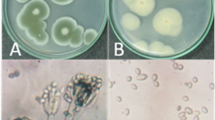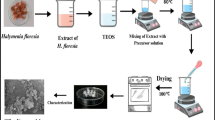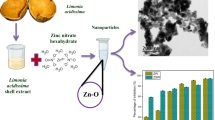Abstract
Titania/silica nanomaterials have many possible applications; however, they can be toxic to living organisms, particularly if the material accumulates in niche environments, e.g. areas colonised by actinomycetes. This study therefore investigated the effect of non-activated and UV light-activated titania/silica nanospheres on an environmental Streptomyces strain. The bacteria were incubated with the nanospheres and subsequently cultured on solid medium. The morphology and elemental composition were analysed using optical and electron microscopy (TEM, STEM) and energy-dispersive X-ray spectroscopy (EDX). The appearance of Streptomyces sp. in the experimental and control samples demonstrated that the nanospheres did not have bactericidal properties in the used dose. Furthermore, the observed strain not only survived in the presence of the nanomaterial but also appeared to play a role in its dissolution with an accumulation of the titanium in the intracellular globules of polyphosphate (volutin). Additionally, it was discovered that the UV light-activated titanium dioxide altered the ability of the bacteria to secrete humic acid. The reported phenomenon might be made possible through an accumulation of titanium in the volutin compounds. These findings suggest that streptomycetes could be employed to participate in the dissolution of nanomaterials which enter the natural environment.







Similar content being viewed by others
References
Achbergerová, L., Nahálka, J. (2011). Polyphosphate—an ancient energy source and active metabolic regulator. Microbial Cell Factories 10. doi: 10.1186/1475-2859-10-63
Borm, P. J. A., Robbins, D., Haubold, S., Kuhibusch, T., Fissan, H., Donaldson, K., Schins, R., Stone, V., Kreyling, W., Lademann, J., Hartmann, J., Warheit, D., & Oberdorfer, J. (2006). The potential risk of nanomaterials: a review carried out for ECETOC. Particle and Fibre Toxicology, 3, 1–25. doi:10.1186/1743-8977-3-11.
Cauda, V., Schlossbauer, A., & Bein, T. (2010). Bio-degradation study of colloidal mesoporous silica nanoparticles: effect of surface functionalization with organo-silanes and poly(ethylene glycol). Microporous and Mesoporous Materials, 132, 60–71. doi:10.1016/j.micromeso.2009.11.015.
Cendrowski, K., Chen, X., Zielinska, B., Kalenczuk, R. J., Rümmeli, M. H., Büchner, B., Klingeler, R., & Borowiak-Palen, E. (2011). Synthesis, characterization, and photocatalytic properties of core/shell mesoporous silica nanospheres supporting nanocrystalline titania. Journal of Nanoparticle Research, 13, 5899–5908. doi:10.1007/s11051-011-0307-1.
Cendrowski, K., Peruzynska, M., Markowska-Szczupak, A., Chen, X., Wajda, A., Lapczuk, J., Kurzawski, M., Kalenczuk, R., Drozdzik, M., Mijowska, E. (2013) Mesoporous silica nanospheres functionalized by TiO2 as a photoactive antibacterial agent. Journal of Nanomedicine Nanotechnology 4. doi: 10.4172/2157-7439.1000182.
Cendrowski, K., Jedrzejczak, M., Dybus, A., Peruzynska, M., Drozdzik, M., & Mijowska, E. (2014a). Preliminary study towards enhancement of photoactivity performance using biocompatible titanium dioxide/carbon nanotubes composite. Journal of Alloys and Compounds, 605(25), 173–178. doi:10.1016/j.jallcom.2014.03.112.
Cendrowski, K., Peruzynska, M., Markowska-Szczupak, A., Chen, X., Wajda, A., Lapczuk, J., Kurzawski, M., Kalenczuk, R. J., Drozdzik, M., & Mijowska, E. (2014b). Antibacterial performance of nanocrystallined titania confined in mesoporous silica nanotubes. Biomedical Microdevices, 16, 449–458. doi:10.1007/s10544-014-9847-3.
Christian, P., von der Kammer, F., Baalousha, M., & Hofmann, T. (2008). Nanoparticles: structure, properties, preparation and behaviour in environmental media. Ecotoxicology, 17, 326–343. doi:10.1007/s10646-008-0213-1.
Dong-Wook, L., Son-Ki, I., & Kew-Ho, L. (2005). Mesostructure control using a titania-coated silica nanosphere framework with extremely high thermal stability. Chemistry of Materials, 17, 4461–4467. doi:10.1021/cm050485w.
Finnie, K. S., Waller, D. J., Perret, F. L., Krause-Heuer, A. M., Lin, H. Q., Hanna, J. V., & Barbe, C. J. (2009). Biodegradability of sol–gel silica microparticles for drug delivery. Journal of Sol-Gel Science and Technology, 49, 12–18. doi:10.1007/s10971-008-1847-4.
Ge, Y., Schimel, J. P., & Holden, P. A. (2012). Identification of soil bacteria susceptible to TiO2 and ZnO nanoparticles. Applied and Environmental Microbiology, 78, 6749–6758. doi:10.1128/AEM.00941-12.
Hannah, W., & Thompson, P. B. (2008). Nanotechnology risk and the environment: a review. Journal of Environmental Monitoring, 10, 291–300. doi:10.1039/b718127m.
Hu, K. W., Hsu, K. C., & Yeh, C. S. (2010). pH-dependent biodegradable silica nanotubes derived from Gd(OH)3 nanorods and their potential for oral drug delivery and MR imaging. Biomaterials, 31, 6843–6848. doi:10.1016/j.biomaterials.2010.05.046.
Imamura, S., Tarumoto, H., & Ishida, S. (1989). Decomposition of 1,2-dichloroethane on titanium dioxide/silica. Industrial & Engineering Chemistry Research, 28(10), 1449–1452. doi:10.1021/ie00094a001.
Knauss, K. G., Dibley, M. J., Bourcier, W. L., & Shaw, H. F. (2001). Ti(IV) hydrolysis constants derived from rutile solubility measurements made from 100 to 300 C. Applied Geochemistry, 16, 1115–1128. doi:10.1016/S0883-2927(00)00081-0.
Kunzmann, A., Andersson, B., Thurnherr, T., Krug, H., Scheynius, A., & Fadeel, B. (2011). Toxicology of engineered nanomaterials: focus on biocompatibility, biodistribution and biodegradation. Biochimica et Biophysica Acta, 1810, 361–373. doi:10.1016/j.bbagen.2010.04.007.
Küster, E., & Williams, S. T. (1964). Selection of media for isolation of Streptomycetes. Nature, 202, 928–929. doi:10.1038/202928a0.
Lai, W., Ducheyne, P., Garino, J. (1998). Removal pathway of silicon released from bioactive glass granules in vivo. In: R.Z. LeGeros, L. LeGeros, (Ed.) (pp. 383–386). Bioceramics. World Scientific Publishing Co., Singapore.
Li, X., Zhang, L., Dong, X., Liang, J., & Shi, J. (2007). Preparation of mesoporous calcium doped silica spheres with narrow size dispersion and their drug loading and degradation behaviour. Journal of Microporous and Mesoporous Materials, 102, 151–158. doi:10.1016/j.micromeso.2006.12.048.
Li, Z., Hou, B., Xu, Y., Wu, D., & Sun, Y. (2005). Hydrothermal synthesis, characterization, and photocatalytic performance of silica-modified titanium dioxide nanoparticles. Journal of Colloid and Interface Science, 288, 149–154. doi:10.1016/j.jcis.2005.02.082.
Linley, S., Liu, Y. Y., Ptacek, C. J., Blowes, D. W., & Gu, F. X. (2014). Recyclable graphene oxide-supported titanium dioxide photocatalysts with tunable properties. ACS Applied Materials & Interfaces, 6, 4658–4668. doi:10.1021/am4039272.
Liu, H., Deng, L., Sun, C., Li, J., & Zhu, Z. (2015). Titanium dioxide encapsulation of supported Ag nanoparticles on the porous silica bead for increased photocatalytic activity. Applied Surface Science, 326, 82–90. doi:10.1016/j.apsusc.2014.11.110.
Liu, K., Lin, X., & Zhao, J. (2013). Toxic effects of the interaction of titanium dioxide nanoparticles with chemicals or physical factors. International Journal of Nanomedicine, 8, 2509–2520. doi:10.2147/IJN.S46919.
Maurer-Jones, M. A., Gunsolus, I. L., Meyer, B. M., Christenson, C. J., & Haynes, C. L. (2013). Impact of TiO2 nanoparticles on growth, biofilm formation, and flavin secretion in Shewanella oneidensis. Analytical Chemistry, 85, 5810–5818. doi:10.1021/ac400486u.
Navarro, E., Baun, A., Behra, R., Hartmann, N. B., Filser, J., Miao, A. J., Quigg, A., Santschi, P. H., & Sigg, L. (2008). Environmental behaviour and ecotoxicity of engineered nanoparticles to algae, plants and fungi. Ecotoxicology, 17, 372–386. doi:10.1007/s10646-008-0214-0.
Negoda, A., Negoda, E., Xian, M., & Reusch, R. N. (2009). Role of polyphosphate in regulation of the Streptomyces lividans KcsA channel. Biochimica et Biophysica Acta, 1788, 608–614. doi:10.1016/j.bbamem.2008.12.017.
Oguma, J., Kakuma, Y., Murayama, S., & Nosaka, Y. (2013). Effects of silica coating on photocatalytic reactions of anatase titanium dioxide studied by quantitative detection of reactive oxygen species. Applied Catalysis B: Environmental, 129(17), 282–286. doi:10.1016/j.apcatb.2012.09.034.
Ortiz, D., & Groves, M. R. (2009). The three-component signalling system HbpS–SenS–SenR as an example of a redox sensing pathway in bacteria. Amino Acids, 37, 479–486.
Palanichamy, V., Hundet, A., Mitra, B., & Reddy, N. (2011). Optimization of cultivation parameters for growth and pigment production by Streptomyces spp. isolated from marine sediment and rhizosphere soil. The International Journal of Plant, Animal and Environmental Sciences, 1, 158–170.
Paredes, D., Ortiz, C., & Torres, R. (2014). Synthesis, characterization, and evaluation of antibacterial effect of Ag nanoparticles against Escherichia coli O157:H7 and methicillin-resistant Staphylococcus aureus (MRSA). International Journal of Nanomedicine, 9, 1717–1729. doi:10.2147/IJN.S57156.
Petković, J., Küzma, T., Rade, K., Novak, S., & Filipi, M. (2011). Pre-irradiation of anatase TiO2 particles with UV enhances their cytotoxic and genotoxic potential in human hepatoma HepG2 cells. Journal of Hazardous Materials, 196, 145–152.
Piccinno F., Gottschalk F., Seeger S., Nowack B. (2012). Industrial production quantities and uses of ten engineered nanomaterials in Europe and the world. Journal of Nanoparticle Research 14. doi:10.1007/s11051-012-1109-9
Schmidt, J., & Vogelsberger, W. (2006). Dissolution kinetics of titanium dioxide nanoparticles the observation of an unusual kinetic size effect. Journal of Physical Chemistry B, 110, 3955–3963. doi:10.1021/jp055361l.
Solecka, J., Ziemska, J., Rajnisz, A., Laskowska, A., & Guśpiel, A. (2013). Actinomycetes—occurrence and production of biologically active compounds. Postępy Mikrobiologii, 52, 83–91.
Stankovic, N., Radulovic, V., Petkovic, M., Vuckovic, I., Jadranin, M., Vasiljevic, B., & Nikodinovic-Runic, J. (2012). Streptomyces sp. JS520 produces exceptionally high quantities of undecylprodigiosin with antibacterial, antioxidative, and UV-protective properties. Applied Microbiology and Biotechnology, 96, 1217–1231. doi:10.1007/s00253-012-4237-3.
Tung, W. S., & Daoud, W. A. (2009). New approach toward nanosized ferrous ferric oxide and Fe3O4-doped titanium dioxide photocatalysts. ACS Applied Materials & Interfaces, 1, 2453–2461.
Yamada, H., Urata, C., Aoyama, Y., Osada, S., Yamauchi, Y., & Kuroda, K. (2012). Preparation of colloidal mesoporous silica nanoparticles with different diameters and their unique degradation behavior in static aqueous systems. Chemistry of Materials, 24, 1462–147. doi:10.1021/cm3001688.
Weir, A., Westerhoff, P., Fabricius, L., & Goetz, N. (2012). Titanium dioxide nanoparticles in food and personal care products. Environmental Science and Technology, 46, 2242–2250. doi:10.1021/es204168d.
Ziemniak, S. E., Jones, M. E., & Combs, K. E. S. (1993). Solubility behavior of titanium(IV) oxide in alkaline media at elevated temperatures. Journal of Solution Chemistry, 22, 601–623. doi:10.1007/BF00646781.
Acknowledgments
The authors are grateful for the financial support of the National Science Centre Poland within the PRELUDIUM Programme (2011/03/N/ST5/04696). We also thank Dr. Jonathan Winfield for his assistance in improvement of the text’s clarity and language.
Author information
Authors and Affiliations
Corresponding author
Ethics declarations
Conflict of Interest
The authors declare that they have no conflict of interest.
Electronic Supplementary Material
Below is the link to the electronic supplementary material.
ESM 1
(PDF 354 kb)
Rights and permissions
About this article
Cite this article
Augustyniak, A., Cendrowski, K., Nawrotek, P. et al. Investigating the Interaction Between Streptomyces sp. and Titania/Silica Nanospheres. Water Air Soil Pollut 227, 230 (2016). https://doi.org/10.1007/s11270-016-2922-z
Received:
Accepted:
Published:
DOI: https://doi.org/10.1007/s11270-016-2922-z




